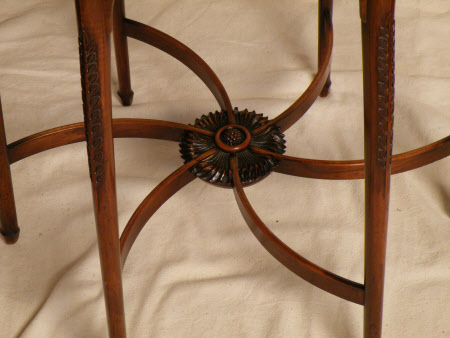Occasional table
Morris & Co.
Category
Furniture
Date
circa 1890
Materials
Walnut
Measurements
68.5 cm (Height); 76 cm (Diameter)
Order this imageCollection
Standen House and Garden, West Sussex
NT 1214006
Summary
A walnut occasional or centre table, by Morris & Co., circa 1890. Designed by George Jack. The overhanging top of moulded undulating circular shape, with arched friezes and raised on six turned slender legs carved with stiff leaf detail and terminating in pointed hexagonal toes, the stretchers shaped as six curved spokes joined to a central carved sunflower motif, stamped to underside MORRIS & Co. 449 OXFORD ST. W 1000. H. Blairman & Sons included an identical table in their Annual catalogue of 2011 which included the following information : - It was almost certainly first shown at the Arts & Crafts Exhibition Society exhibition of 1890. - It was number 376 in Specimens of Furniture Upholstery & Interior Decoration issued by Morris & Co. circa 1900–10. This same table was illustrated in John Andrews 'Arts and Crafts Furniture', 2005, plate 52.An identical table is shown in the Drawing Room at Stanmore Hall, a Morris & Co. commission (Jeremy Cooper 'Victorian and Edwardian Furniture and Interiors' 1987, Fig 473). Other examples of this table are in the collection of the Saint Louis Art Museum (189–1990) and the Los Angeles County Museum of Art (M.2003–79). This highly distinctive table is arguably one of the most iconic designs of the period.
Full description
George Jack (1855-1931), architect and designer, designed furniture for Morris & Co. from 1880, after working in the offices of Philip Webb. Founded in 1861 as Morris, Marshall, Faulkner & Co., the firm was soon referred to as Morris & Co., although the name was not officially adopted until 1875 when William Morris (1834-1896) became sole proprietor. Responsibility for the design of almost all commissioned furniture passed to Philip Webb, whose influence was enormous, and (from 1880) his assistant George Jack, while Morris produced designs for glass, tapestries and any painted furniture. From 1871 wallpapers, designed by Morris, became an important part of the business. Show rooms in Oxford Street were acquired in 1877. Greater commercial success in the 1880s led to the opening of a shop in Manchester in 1883. Some of the well-known interior schemes undertaken by Morris include Rounton Grange in Yorkshire, Old Swan House in Chelsea, Great Tangley Manor in Surrey, Wightwick Manor, Bullers Wood and Standen.
Marks and inscriptions
To underside of top: MORRIS & Co. 449 OXFORD ST. W 1000
Makers and roles
Morris & Co., manufacturer George Washington Jack (1855-1932), designer
References
Blairman, H. & Sons Annual catalogue, 2011 Andrews, John - Arts and Crafts Furniture, ACC 2005, plate 52 Cooper, Jeremy 'Victorian and Edwardian Furniture and Interiors (1987), Fig 473

